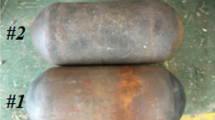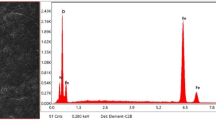Abstract
In the manufacturing industries, heat treatment is extremely important process to achieve desirable thermo-mechanical properties of engineering materials by controlling the specific austenitizing temperature range. These desirable properties were evaluated with several conventional techniques. However, these techniques are more time-consuming, costly, and destructive in nature. To overcome the above serious inspection issues, magnetic nondestructive techniques such as Barkhausen noise (BN) and hysteresis loop (HL) were adopted for surface characterization of different heat-treated AISI 1040 steel at various austenitizing temperatures, i.e., 800, 850, and 900°C. Surface properties were evaluated in terms of microstructure, grain size, and microhardness. BN and HL responses of the heat-treated samples were reported in terms of root mean square (RMS), coercivity, HL, and BN envelope. The experimental results indicated that the drastic variation in the microstructure and microhardness of primary surface and subsurface was observed under quenching at austenitizing temperature 900°C due to rapid cooling of lath martensite, which restricts the formation of perlite. According to nondestructive evaluation, higher BN-RMS and lower coercivity were obtained in annealed samples. A linear correlation between magnetic response variables (BN-RMS and coercivity) and material properties (microhardness and grain size) was obtained at different magnetizing frequencies. Small HL and BN envelopes were found in the quenched sample because of restricted magnetic domains alignment with magnetic field under a fine lath martensite structure.










Similar content being viewed by others
REFERENCES
Stashkov, A., Nichipuruk, A., Ogneva, M., and Kuleev, V., The effect of plastic strain and the orthogonal bias field on the processes of magnetization of low-carbon steel, Russ. J. Nondestr. Test., 2012, vol. 48, no. 12, pp. 686–692.
Shah, A., Ali, G., Khan, T. M. R., Shah, A., Imran, M., and Nisar, S., Evaluation of heat treatment effect on the tensile strength of mild steel welded joints using ultrasonic testing, Russ. J. Nondestr. Test., 2021, vol. 57, no. 6, pp. 455–464.
Thelning, K.E., Steel and Its Heat Treatment, Oxford: Butterworth-Heinemann, 2013.
Lasaosa, A., Gurruchaga, K., Arizti, F., and Martinez-De-Guerenu, A., Induction hardened layer characterization and grinding burn detection by magnetic Barkhausen noise analysis, J. Nondestr. Eval., 2017, vol. 36, no. 2, p. 27.
Baldev, R., Jayakumar, T., Moorthy, V., and Vaidyanathan, S., Characterisation of microstructures, deformation, and fatigue damage in different steels using magnetic Barkhausen emission technique, Russ. J. Nondestr. Test., 2001, vol. 37, no. 11, pp. 789–798.
Shrivastava, A.K., Sharma, A., Awale, A.S., Yusufzai, M.Z.K., and Vashista, M., Assessment of grinding burn of AISI D2 tool steel using Barkhausen noise technique, J. Inst. Eng.: C, 2021, vol. 102, no. 4, pp. 885–896.
Srivastava, A., Awale, A., Vashista, M., and Yusufzai, M. K., Characterization of ground steel using nondestructive magnetic Barkhausen noise technique, J. Mater. Eng. Perform., 2020, vol. 29, no. 7, pp. 4617–4625.
Noskova, N., Shulika, V., Lavrent’ev, A., Potapov, A., and Korzunin, G., Structure and Barkhausen effect parameters of amorphous alloys after various heat treatments, Russ. J. Nondestr. Test., 2004, vol. 40, no. 9, pp. 620–624.
Devine, M.K., The magnetic detection of material properties, J. Nondestr. Eval., 1992, vol. 44, no. 10, pp. 24–30.
Singh, S.S., Awale, A.S., Chaudhari, A., and Nahak, B., Monitoring the microstructural changes of heat treated medium carbon steel by Barkhausen noise and hysteresis loop techniques, Mater. Today Proc., 2020, vol. 26, pp. 1198–1202.
Sharma, A., Chaudhari, A., Awale, A.S., Yusufzai, M.Z.K., and Vashista, M., Effect of grinding environments on magnetic response of AISI D2 tool steel, Russ. J. Nondestr. Test., 2021, vol. 57, no. 3, pp. 212–221.
Li, Y., Chen, J., Wang, J., Zhao, H., and Chen, L., Study on the residual stress distribution of railway rails, Proc. Inst. Mech. Eng. C, 2020, vol. 234, no. 23, pp. 4682–4694.
Kishore, G., Mariappan, K., Kumar, A., Shankar, V., Sandhya, R., Rao, B.P., and Laha, K., Characterization of high Temperature (873 K) low cycle fatigue damage in modified 9Cr–1Mo steel using magnetic Barkhausen emission technique, Trans. Indian Inst. Met., 2016, vol. 69, no. 2, pp. 315–318.
Wu, J., Liu, C., Li, E., Zhu, J., Ding, S., and Wang, Y., Motion-induced magnetic Barkhausen noise for evaluating applied stress in pipelines, J. Nondestr. Eval., 2020, vol. 39, no. 4, pp. 1–12.
Jedamski, R., Heinzel, J., Rößler, M., Epp, J., Eckebrecht, J., Gentzen, J., Putz, M., and Karpuschewski, B., Potential of magnetic Barkhausen noise analysis for in-process monitoring of surface layer properties of steel components in grinding, tm-Technisches Messen, 2020, vol. 87, no. 12, pp. 787–798.
Neslusan, M., Cizek, J., Kolarik, K., Minarik, P., Cillikova, M., and Melikhova, O., Monitoring of grinding burn via Barkhausen noise emission in case-hardened steel in large-bearing production, J. Mater. Process. Tech., 2017, vol. 240, pp. 104–117.
Lindgren, M. and Lepistö, T., Relation between residual stress and Barkhausen noise in a duplex steel, NDT & E Int., 2003, vol. 36, no. 5, pp. 279–288.
Moorthy, V., Shaw, B., Mountford, P., and Hopkins, P., Magnetic Barkhausen emission technique for evaluation of residual stress alteration by grinding in case-carburised En36 steel, Acta Mater., 2005, vol. 53, no. 19, pp. 4997–5006.
Vashista, M. and Paul, S., Novel processing of Barkhausen noise signal for assessment of residual stress in surface ground components exhibiting poor magnetic response, J. Magn. Magn. Mater., 2011, vol. 323, no. 21, pp. 2579–2584.
Roitburd, A. and Kurdjumov, G., The nature of martensitic transformations, Mater. Sci. Eng., 1979, vol. 39, no. 2, pp. 141–167.
Grajcar, A. and Opiela, M., Influence of plastic deformation on CCT-diagrams of low-carbon and medium-carbon TRIP-steels, J. Achiev. Mater. Manuf. Eng., 2008, vol. 29, no. 1, pp. 71–78.
Hall, E., The deformation and ageing of mild steel: III discussion of results, Proc. Phys. Soc. B, 1951, vol. 64, no. 9, p. 747.
Lee, S.J. and Lee, Y.K., Prediction of austenite grain growth during austenitization of low alloy steels, Mater. Des., 2008, vol. 29, no. 9, pp. 1840–1844.
Weidner, A., Hangen, U.D., and Biermann, H., Nanoindentation measurements on deformation-induced α'-martensite in a metastable austenitic high-alloy CrMnNi steel, Philos. Mag. Lett., 2014, vol. 94, no. 8, pp. 522–530.
Białobrzeska, B., Konat, Ł., and Jasiński, R., The influence of austenite grain size on the mechanical properties of low-alloy steel with boron, Metals, 2017, vol. 7, no. 1, p. 26.
Thorat, S. and Sadaiah, M., The effect of residual stresses, grain size, grain orientation, and hardness on the surface quality of Co–Cr L605 alloy in photochemical machining, J. Alloys Compd., 2019, vol. 804, pp. 84–92.
Stump, D.R., Electromagnetism, in Encyclopedia of Energy, Cleveland, C.J., Ed., New York: Elsevier, 2004, pp. 319–328.
Wang, S., Li, L., Zhao, X., and Xie, Y., Fixed-point time-periodic FEM taking into account hysteresis characteristics of laminated core under DC bias, Int. J. Appl. Electromagn., 2017, vol. 55, no. 2, pp. 289–300.
Kahrobaee, S. and Hejazi, T.-H., A RSM-based predictive model to characterize heat treating parameters of D2 steel using combined Barkhausen noise and hysteresis loop methods, J. Magn. Magn. Mater., 2017, vol. 433, pp. 131–140.
Zagainov, A., Ul’yanov, A., Chulkina, A., and Zykina, I., The effect of cementite on the formation of the magnetic hysteresis properties of thermally treated carbon steels, Russ. J. Nondestr. Test., 2012, vol. 48, no. 1, pp. 35–43.
Awale, A., Shrivastava, A.K., Chaudhari, A., Yusufzai, M.Z.K., and Vashista, M., Micro-magnetic characterisation of ground AISI D2 tool steel using hysteresis loop technique, Int. J. Mater. Prod. Technol., 2021, vol. 62, nos. 1–3, pp. 180–198.
ACKNOWLEDGMENTS
The authors would like to thank Dr. Meghanshu Vashista and Dr. Mohd Zaheer Khan Yusufzai for providing an experimental facility at Department of Mechanical Engineering, Indian Institute of Technology (BHU), Varanasi.
Author information
Authors and Affiliations
Corresponding author
Ethics declarations
The authors declare that they have no conflicts of interest.
Rights and permissions
About this article
Cite this article
Singh, S.S., Awale, A.S. & Nahak, B. Assessment the Surface Characteristics of Heat-Treated AISI 1040 Steel Using Magnetic Nondestructive Techniques. Russ J Nondestruct Test 58, 369–380 (2022). https://doi.org/10.1134/S1061830922050072
Received:
Revised:
Accepted:
Published:
Issue Date:
DOI: https://doi.org/10.1134/S1061830922050072




